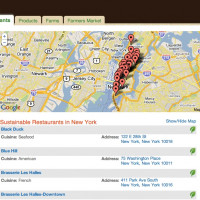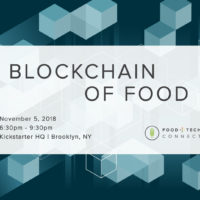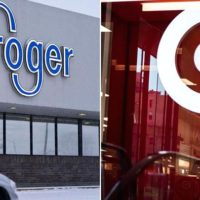“Knowing where your food comes from” is arguably today’s biggest food trend. But to Sourcemap CEO Leonardo Bonanni PhD, traceability is far more than a fad. He and his team have created a crowdsourced directory of product supply chains and environmental footprints, making possible public information on everything from laptop computers to orange juice.
I spoke with Bonanni and Sourcemap’s Bianca Sayan about creating true transparency through crowdsourced mapping, the data challenges to their work, and their project locating the major crops in the U.S. as part of the Farm Bill Hackathon.
 Beth Hoffman: What is unique about Sourcemap?
Beth Hoffman: What is unique about Sourcemap?
Leo Bonanni: Sourcemap is the only platform built for supply chain transparency that is crowdsourced, open, and can be embedded anywhere. You can also calculate the carbon footprint of products on our site. We are working to democratize information from the ground up so we can all make more sustainable choices.
When we started, we thought, the most expedient way to collect this information and make it available was to open it to anyone, to be a YouTube for supply chains. Anyone who knows about a product can make a map, assess a product’s impact, and share it in social media channels.
Initially researchers and students were curious to use Sourcemap to look at the environmental impact of products. Then we found small business wanted to use the tool to show the care they take in sourcing. Now we are finding bigger companies are approaching us to see what they can do with it to create better transparency and to collect information from their suppliers. Many of these companies currently use suppliers, not based on data, but because of long standing relationships. But to now say, let’s put suppliers big and small on a map, levels the playing field. Then companies can chose who to buy from based on the actual impact of their purchase.
Sourcemap is also a teaching tool – to learn where products come from and the impact of making, using, and throwing them away. Our open source impact calculator is the only one I know of on the web.
BH: What do you find is different about mapping food from other products?
LB: Food is by far the preferred thing to map on Sourcemap. At least half of the maps – the overwhelming majority – are created about food. It is interesting culturally – we seem to have an increasing desire to know what we are putting into our bodies and there is more scholarship around how food is produced and why.
Agricultural products are also unique. The basic difference is that while Apple might have one supplier to put together the bulk of a product, Nestlè or Mars have hundreds of farmers involved with a single food product. With that amount of complexity, it is hard to have traceability. But that is exactly why mapping sources can have such an impact. If we are not connected to the supply chain of the food we eat, we just can’t understand the impact we are having on the earth. And food is one of those things that is so complex, it is a huge task.
BH: Are you finding it is hard for people to understand how complex their food supply chains really are?
LB: When there were all the recalls on pet food, we had many requests for us to trace it. I thought that was really interesting because I wondered if those same people know that most of the food they eat is not traceable.
I think we have been misled about traceability. Many people think that if food is certified organic or Fair Trade, then we know where food is coming from. But we just don’t. I think when people start seeing the first products on the shelf with bar codes detailing where products are coming from and how food was grown, then maybe people will understand the difference between companies that are providing real transparency and those that are not. That will be the real game changer – when people can compare products based on what information the brand allows you to see.
BH: Talk about what you did around the Farm Bill Hackathon and how you see that playing into your goals at Sourcemap?
Bianca Sayan: What I did for Farm Bill Hackathon was I went to the wiki, and I looked at the project ideas to see if there was something I could work on. I thought Connecting Consolidation in Agriculture to Food Miles by Food & Water Watch was a good project for us to see where food is being grown and how far it is away from people buying it. I decided to map it out using Sourcemap to figure out how far food travels. This would allow for consumers to connect themselves to different raw agricultural products to see the distance it travels and their carbon footprint.
I ended up mapping barley and catfish production first because there is good county data for those foods. For other crops the data is not as good, and we will have to make decisions how to map them at state level data.
We also have an open API (Application Program Interface) so that other websites and computers can use the data available on our site. This means that someone can take the geodata I put into the website about producers and layer it over their own maps – say of climate or population centers – to find out the distance food travels and the carbon footprint of particular products.
LB: Our real dream for the crop maps is to have much more county level data. But there is talk of cut backs in USDA funding, and I don’t know if it will exist.
Even with the government data, most of it focuses on commodity crops and doesn’t go all the way back to the farmers. We would like farmers take the data we put in and enhance it, by telling us where they are exactly, about their farms and what they grow. They can add photos even. That way they become real places on a map and not just part of a group of county data.
BH: What are the challenges with the data?
BS: For the hackathon project mapping crops, the USDA agricultural census and surveys are pretty good. The interface is decent. It requires cleaning, but it is good data. The problem with it however, is that when you get it from the USDA, you can’t just yank out the information you need. You have to download it, make sense of it, clean it up, and upload it. Once it is in Sourcemap it is far more user friendly, and with the open API, we can turn the data into something people can use right off our site. They can add to it as well.
LB: Part of the problem is that while as a society we have grown comfortable with crowdsourcing via Yelp, Facebook, or Twitter, at the same time government data is still made in closed systems for experts. We need a cultural shift with government data so that they begin to supply data we can use. That is why we have taken an open architectural approach, because we feel there is not nearly enough people able to take advantage of government resources.
We would love to see if we can get help completing project of mapping all the major crops, because it is a big task. We want to go through everything in the USDA surveys and censuses and to map everything in there. Maybe we could even map the historical data to see the movement of where crops are grown now and then.





